Financial Management: Concepts, Statements, Ratios & Improvement
VerifiedAdded on 2023/06/17
|15
|2822
|491
Report
AI Summary
This report provides a comprehensive analysis of financial management, covering key concepts, the importance of financial management, and the main financial statements (Balance Sheet, Income Statement, and Cash-Flow Statements). It explains the usage of ratios in financial management, including liquidity, efficiency, and profitability ratios, with a case study assessment. The report also includes a business review template and balance sheet presentation using Excel. Finally, it discusses procedures for improving financial performance with practical examples, emphasizing human resources engagement and cost reduction. Desklib offers this and many other solved assignments to help students succeed.

IMPORTANCE OF
FINANCIAL
MANAGEMENT
FINANCIAL
MANAGEMENT
Paraphrase This Document
Need a fresh take? Get an instant paraphrase of this document with our AI Paraphraser
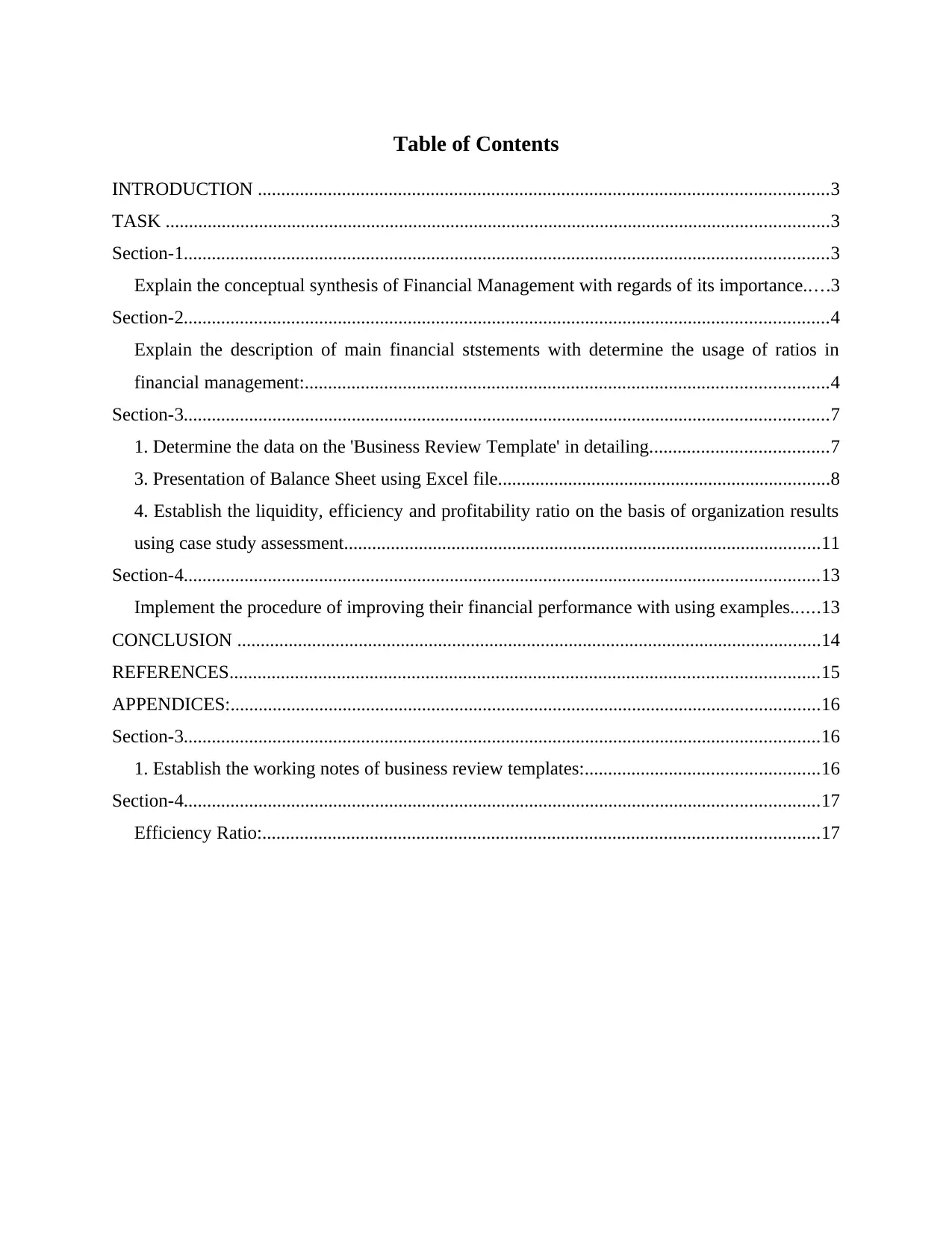
Table of Contents
INTRODUCTION ..........................................................................................................................3
TASK ..............................................................................................................................................3
Section-1..........................................................................................................................................3
Explain the conceptual synthesis of Financial Management with regards of its importance.....3
Section-2..........................................................................................................................................4
Explain the description of main financial ststements with determine the usage of ratios in
financial management:................................................................................................................4
Section-3..........................................................................................................................................7
1. Determine the data on the 'Business Review Template' in detailing......................................7
3. Presentation of Balance Sheet using Excel file.......................................................................8
4. Establish the liquidity, efficiency and profitability ratio on the basis of organization results
using case study assessment......................................................................................................11
Section-4........................................................................................................................................13
Implement the procedure of improving their financial performance with using examples......13
CONCLUSION .............................................................................................................................14
REFERENCES..............................................................................................................................15
APPENDICES:..............................................................................................................................16
Section-3........................................................................................................................................16
1. Establish the working notes of business review templates:..................................................16
Section-4........................................................................................................................................17
Efficiency Ratio:.......................................................................................................................17
INTRODUCTION ..........................................................................................................................3
TASK ..............................................................................................................................................3
Section-1..........................................................................................................................................3
Explain the conceptual synthesis of Financial Management with regards of its importance.....3
Section-2..........................................................................................................................................4
Explain the description of main financial ststements with determine the usage of ratios in
financial management:................................................................................................................4
Section-3..........................................................................................................................................7
1. Determine the data on the 'Business Review Template' in detailing......................................7
3. Presentation of Balance Sheet using Excel file.......................................................................8
4. Establish the liquidity, efficiency and profitability ratio on the basis of organization results
using case study assessment......................................................................................................11
Section-4........................................................................................................................................13
Implement the procedure of improving their financial performance with using examples......13
CONCLUSION .............................................................................................................................14
REFERENCES..............................................................................................................................15
APPENDICES:..............................................................................................................................16
Section-3........................................................................................................................................16
1. Establish the working notes of business review templates:..................................................16
Section-4........................................................................................................................................17
Efficiency Ratio:.......................................................................................................................17
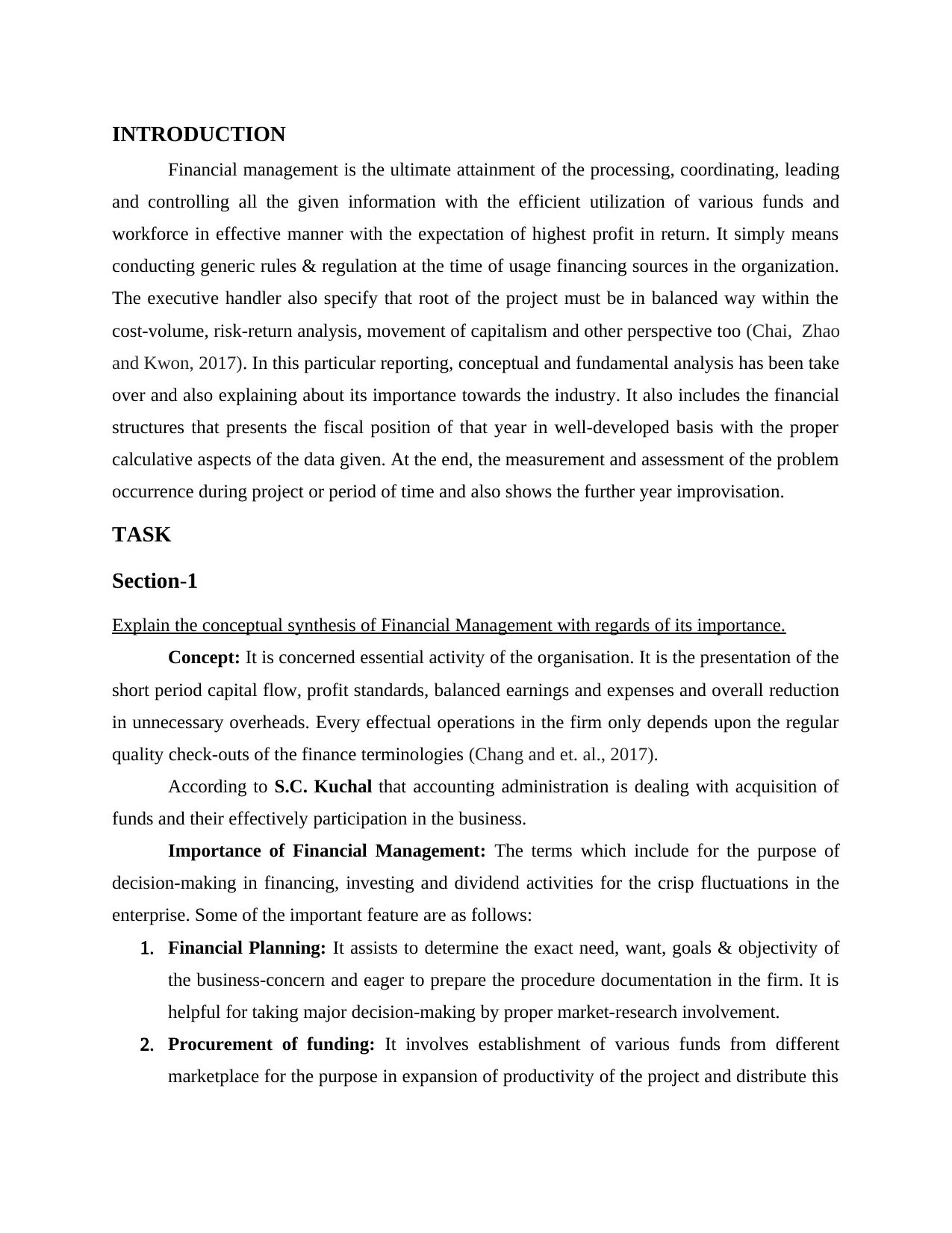
INTRODUCTION
Financial management is the ultimate attainment of the processing, coordinating, leading
and controlling all the given information with the efficient utilization of various funds and
workforce in effective manner with the expectation of highest profit in return. It simply means
conducting generic rules & regulation at the time of usage financing sources in the organization.
The executive handler also specify that root of the project must be in balanced way within the
cost-volume, risk-return analysis, movement of capitalism and other perspective too (Chai, Zhao
and Kwon, 2017). In this particular reporting, conceptual and fundamental analysis has been take
over and also explaining about its importance towards the industry. It also includes the financial
structures that presents the fiscal position of that year in well-developed basis with the proper
calculative aspects of the data given. At the end, the measurement and assessment of the problem
occurrence during project or period of time and also shows the further year improvisation.
TASK
Section-1
Explain the conceptual synthesis of Financial Management with regards of its importance.
Concept: It is concerned essential activity of the organisation. It is the presentation of the
short period capital flow, profit standards, balanced earnings and expenses and overall reduction
in unnecessary overheads. Every effectual operations in the firm only depends upon the regular
quality check-outs of the finance terminologies (Chang and et. al., 2017).
According to S.C. Kuchal that accounting administration is dealing with acquisition of
funds and their effectively participation in the business.
Importance of Financial Management: The terms which include for the purpose of
decision-making in financing, investing and dividend activities for the crisp fluctuations in the
enterprise. Some of the important feature are as follows:
1. Financial Planning: It assists to determine the exact need, want, goals & objectivity of
the business-concern and eager to prepare the procedure documentation in the firm. It is
helpful for taking major decision-making by proper market-research involvement.
2. Procurement of funding: It involves establishment of various funds from different
marketplace for the purpose in expansion of productivity of the project and distribute this
Financial management is the ultimate attainment of the processing, coordinating, leading
and controlling all the given information with the efficient utilization of various funds and
workforce in effective manner with the expectation of highest profit in return. It simply means
conducting generic rules & regulation at the time of usage financing sources in the organization.
The executive handler also specify that root of the project must be in balanced way within the
cost-volume, risk-return analysis, movement of capitalism and other perspective too (Chai, Zhao
and Kwon, 2017). In this particular reporting, conceptual and fundamental analysis has been take
over and also explaining about its importance towards the industry. It also includes the financial
structures that presents the fiscal position of that year in well-developed basis with the proper
calculative aspects of the data given. At the end, the measurement and assessment of the problem
occurrence during project or period of time and also shows the further year improvisation.
TASK
Section-1
Explain the conceptual synthesis of Financial Management with regards of its importance.
Concept: It is concerned essential activity of the organisation. It is the presentation of the
short period capital flow, profit standards, balanced earnings and expenses and overall reduction
in unnecessary overheads. Every effectual operations in the firm only depends upon the regular
quality check-outs of the finance terminologies (Chang and et. al., 2017).
According to S.C. Kuchal that accounting administration is dealing with acquisition of
funds and their effectively participation in the business.
Importance of Financial Management: The terms which include for the purpose of
decision-making in financing, investing and dividend activities for the crisp fluctuations in the
enterprise. Some of the important feature are as follows:
1. Financial Planning: It assists to determine the exact need, want, goals & objectivity of
the business-concern and eager to prepare the procedure documentation in the firm. It is
helpful for taking major decision-making by proper market-research involvement.
2. Procurement of funding: It involves establishment of various funds from different
marketplace for the purpose in expansion of productivity of the project and distribute this
⊘ This is a preview!⊘
Do you want full access?
Subscribe today to unlock all pages.

Trusted by 1+ million students worldwide
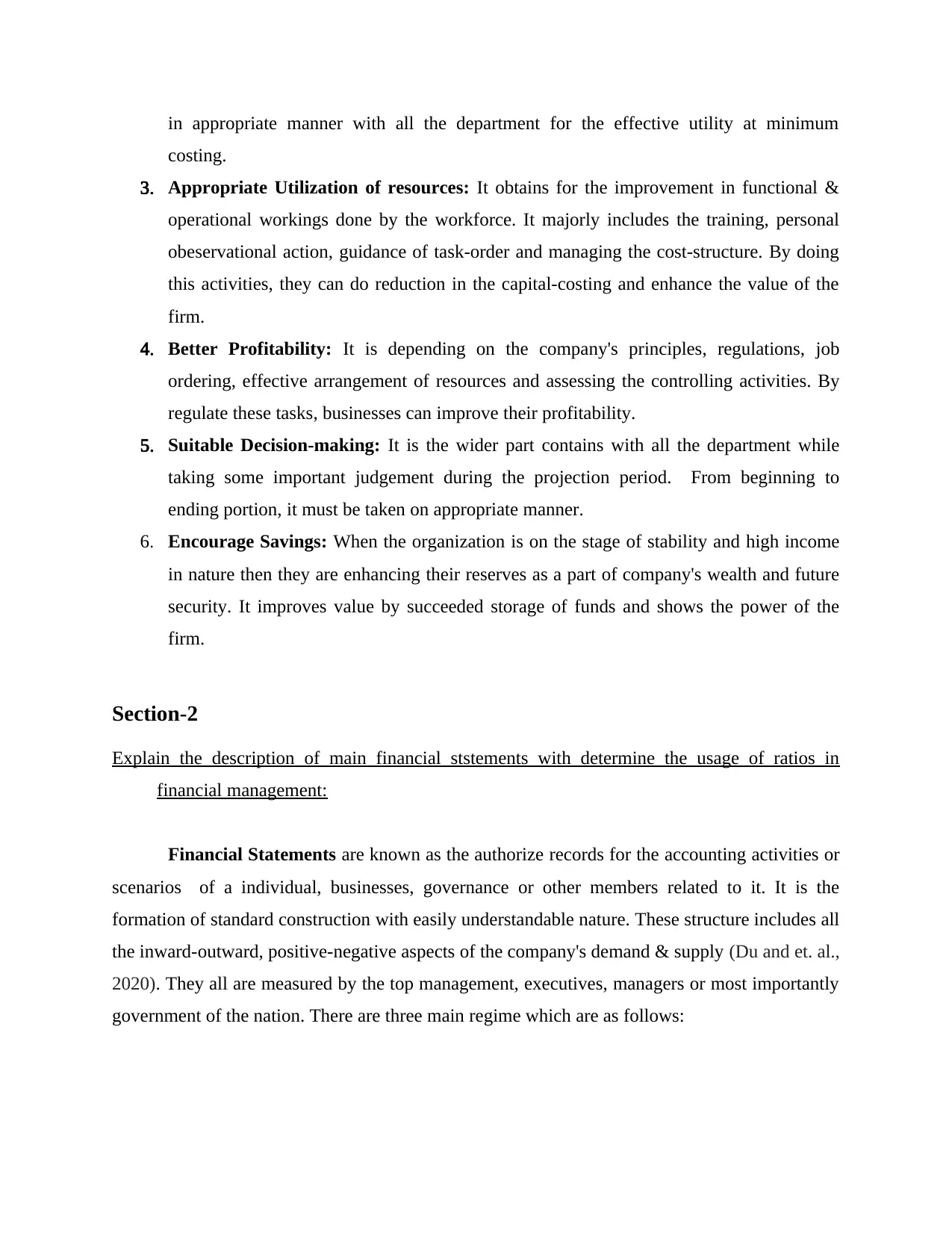
in appropriate manner with all the department for the effective utility at minimum
costing.
3. Appropriate Utilization of resources: It obtains for the improvement in functional &
operational workings done by the workforce. It majorly includes the training, personal
obeservational action, guidance of task-order and managing the cost-structure. By doing
this activities, they can do reduction in the capital-costing and enhance the value of the
firm.
4. Better Profitability: It is depending on the company's principles, regulations, job
ordering, effective arrangement of resources and assessing the controlling activities. By
regulate these tasks, businesses can improve their profitability.
5. Suitable Decision-making: It is the wider part contains with all the department while
taking some important judgement during the projection period. From beginning to
ending portion, it must be taken on appropriate manner.
6. Encourage Savings: When the organization is on the stage of stability and high income
in nature then they are enhancing their reserves as a part of company's wealth and future
security. It improves value by succeeded storage of funds and shows the power of the
firm.
Section-2
Explain the description of main financial ststements with determine the usage of ratios in
financial management:
Financial Statements are known as the authorize records for the accounting activities or
scenarios of a individual, businesses, governance or other members related to it. It is the
formation of standard construction with easily understandable nature. These structure includes all
the inward-outward, positive-negative aspects of the company's demand & supply (Du and et. al.,
2020). They all are measured by the top management, executives, managers or most importantly
government of the nation. There are three main regime which are as follows:
costing.
3. Appropriate Utilization of resources: It obtains for the improvement in functional &
operational workings done by the workforce. It majorly includes the training, personal
obeservational action, guidance of task-order and managing the cost-structure. By doing
this activities, they can do reduction in the capital-costing and enhance the value of the
firm.
4. Better Profitability: It is depending on the company's principles, regulations, job
ordering, effective arrangement of resources and assessing the controlling activities. By
regulate these tasks, businesses can improve their profitability.
5. Suitable Decision-making: It is the wider part contains with all the department while
taking some important judgement during the projection period. From beginning to
ending portion, it must be taken on appropriate manner.
6. Encourage Savings: When the organization is on the stage of stability and high income
in nature then they are enhancing their reserves as a part of company's wealth and future
security. It improves value by succeeded storage of funds and shows the power of the
firm.
Section-2
Explain the description of main financial ststements with determine the usage of ratios in
financial management:
Financial Statements are known as the authorize records for the accounting activities or
scenarios of a individual, businesses, governance or other members related to it. It is the
formation of standard construction with easily understandable nature. These structure includes all
the inward-outward, positive-negative aspects of the company's demand & supply (Du and et. al.,
2020). They all are measured by the top management, executives, managers or most importantly
government of the nation. There are three main regime which are as follows:
Paraphrase This Document
Need a fresh take? Get an instant paraphrase of this document with our AI Paraphraser
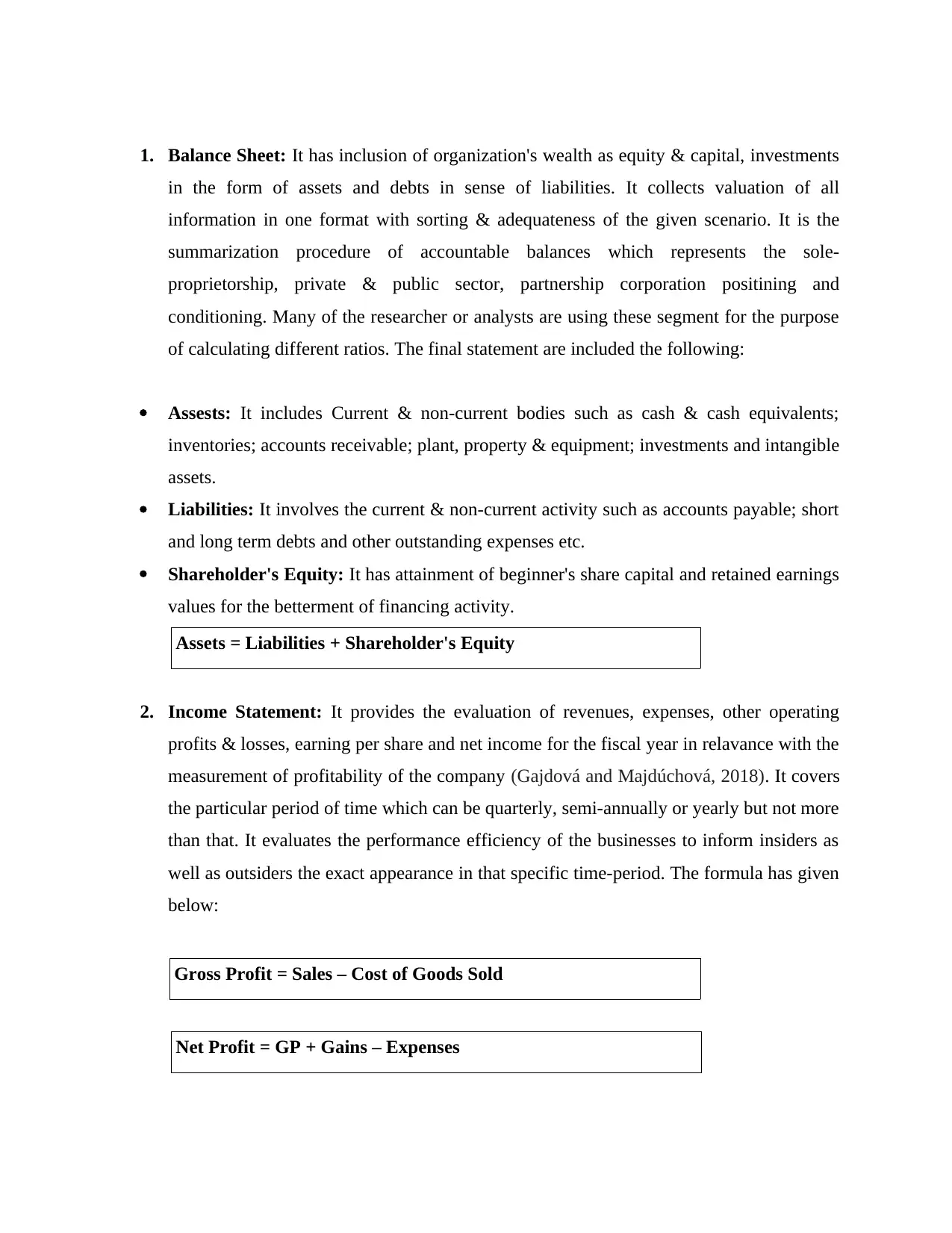
1. Balance Sheet: It has inclusion of organization's wealth as equity & capital, investments
in the form of assets and debts in sense of liabilities. It collects valuation of all
information in one format with sorting & adequateness of the given scenario. It is the
summarization procedure of accountable balances which represents the sole-
proprietorship, private & public sector, partnership corporation positining and
conditioning. Many of the researcher or analysts are using these segment for the purpose
of calculating different ratios. The final statement are included the following:
Assests: It includes Current & non-current bodies such as cash & cash equivalents;
inventories; accounts receivable; plant, property & equipment; investments and intangible
assets.
Liabilities: It involves the current & non-current activity such as accounts payable; short
and long term debts and other outstanding expenses etc.
Shareholder's Equity: It has attainment of beginner's share capital and retained earnings
values for the betterment of financing activity.
Assets = Liabilities + Shareholder's Equity
2. Income Statement: It provides the evaluation of revenues, expenses, other operating
profits & losses, earning per share and net income for the fiscal year in relavance with the
measurement of profitability of the company (Gajdová and Majdúchová, 2018). It covers
the particular period of time which can be quarterly, semi-annually or yearly but not more
than that. It evaluates the performance efficiency of the businesses to inform insiders as
well as outsiders the exact appearance in that specific time-period. The formula has given
below:
Gross Profit = Sales – Cost of Goods Sold
Net Profit = GP + Gains – Expenses
in the form of assets and debts in sense of liabilities. It collects valuation of all
information in one format with sorting & adequateness of the given scenario. It is the
summarization procedure of accountable balances which represents the sole-
proprietorship, private & public sector, partnership corporation positining and
conditioning. Many of the researcher or analysts are using these segment for the purpose
of calculating different ratios. The final statement are included the following:
Assests: It includes Current & non-current bodies such as cash & cash equivalents;
inventories; accounts receivable; plant, property & equipment; investments and intangible
assets.
Liabilities: It involves the current & non-current activity such as accounts payable; short
and long term debts and other outstanding expenses etc.
Shareholder's Equity: It has attainment of beginner's share capital and retained earnings
values for the betterment of financing activity.
Assets = Liabilities + Shareholder's Equity
2. Income Statement: It provides the evaluation of revenues, expenses, other operating
profits & losses, earning per share and net income for the fiscal year in relavance with the
measurement of profitability of the company (Gajdová and Majdúchová, 2018). It covers
the particular period of time which can be quarterly, semi-annually or yearly but not more
than that. It evaluates the performance efficiency of the businesses to inform insiders as
well as outsiders the exact appearance in that specific time-period. The formula has given
below:
Gross Profit = Sales – Cost of Goods Sold
Net Profit = GP + Gains – Expenses

3. Cash-Flow Statements: It has inclusion of the company's inflow and outflow
conditioning and proper management of given information (Hutahayan, 2020). It is the
auto-generated valuation of cash & cash equivalents, effectiveness of the working capital
movement and measures the uses and sources of funds. It includes two methods of
calculation: Direct & Indirect. There is no particular formula for evaluation. It contains
three regime which are as follows:
Operating Activities: It includes daily basis fluctuations which is tax & dividend paid,
depreciation, current assets and liabilities performa, interests, rents etc.
Investing Activities: In this, there is a involvement of the selling & buying of the fixed
bodies which is usable to the firm.
Financing Activities: It is a measurement assessment of the loan & dividend pay-ins &
outs inside the organization.
Usage of ratios: This analysis impacts all the fundamentals and comprehensiveness of
the company. Some of the conditions are as follows:
1. Trend-setting: It is useful for any organization to grab & grasp the opportunities that are
being trending in the external area for the maximum proficiency.
2. Standardization: When one company sets up their marking, then other competitive firm
has come in the market to break its level. But the values and quality grading of the
organization became specificity in nature. If their quality-standards are high, they have
not take any worries regarding competitiveness.
3. Diversification portfolio: If the company's having high delegation of scenario, they can
create low risk with high return in regular basis. The short & long term synergies have
more implications towards the risk-return functioning.
conditioning and proper management of given information (Hutahayan, 2020). It is the
auto-generated valuation of cash & cash equivalents, effectiveness of the working capital
movement and measures the uses and sources of funds. It includes two methods of
calculation: Direct & Indirect. There is no particular formula for evaluation. It contains
three regime which are as follows:
Operating Activities: It includes daily basis fluctuations which is tax & dividend paid,
depreciation, current assets and liabilities performa, interests, rents etc.
Investing Activities: In this, there is a involvement of the selling & buying of the fixed
bodies which is usable to the firm.
Financing Activities: It is a measurement assessment of the loan & dividend pay-ins &
outs inside the organization.
Usage of ratios: This analysis impacts all the fundamentals and comprehensiveness of
the company. Some of the conditions are as follows:
1. Trend-setting: It is useful for any organization to grab & grasp the opportunities that are
being trending in the external area for the maximum proficiency.
2. Standardization: When one company sets up their marking, then other competitive firm
has come in the market to break its level. But the values and quality grading of the
organization became specificity in nature. If their quality-standards are high, they have
not take any worries regarding competitiveness.
3. Diversification portfolio: If the company's having high delegation of scenario, they can
create low risk with high return in regular basis. The short & long term synergies have
more implications towards the risk-return functioning.
⊘ This is a preview!⊘
Do you want full access?
Subscribe today to unlock all pages.

Trusted by 1+ million students worldwide
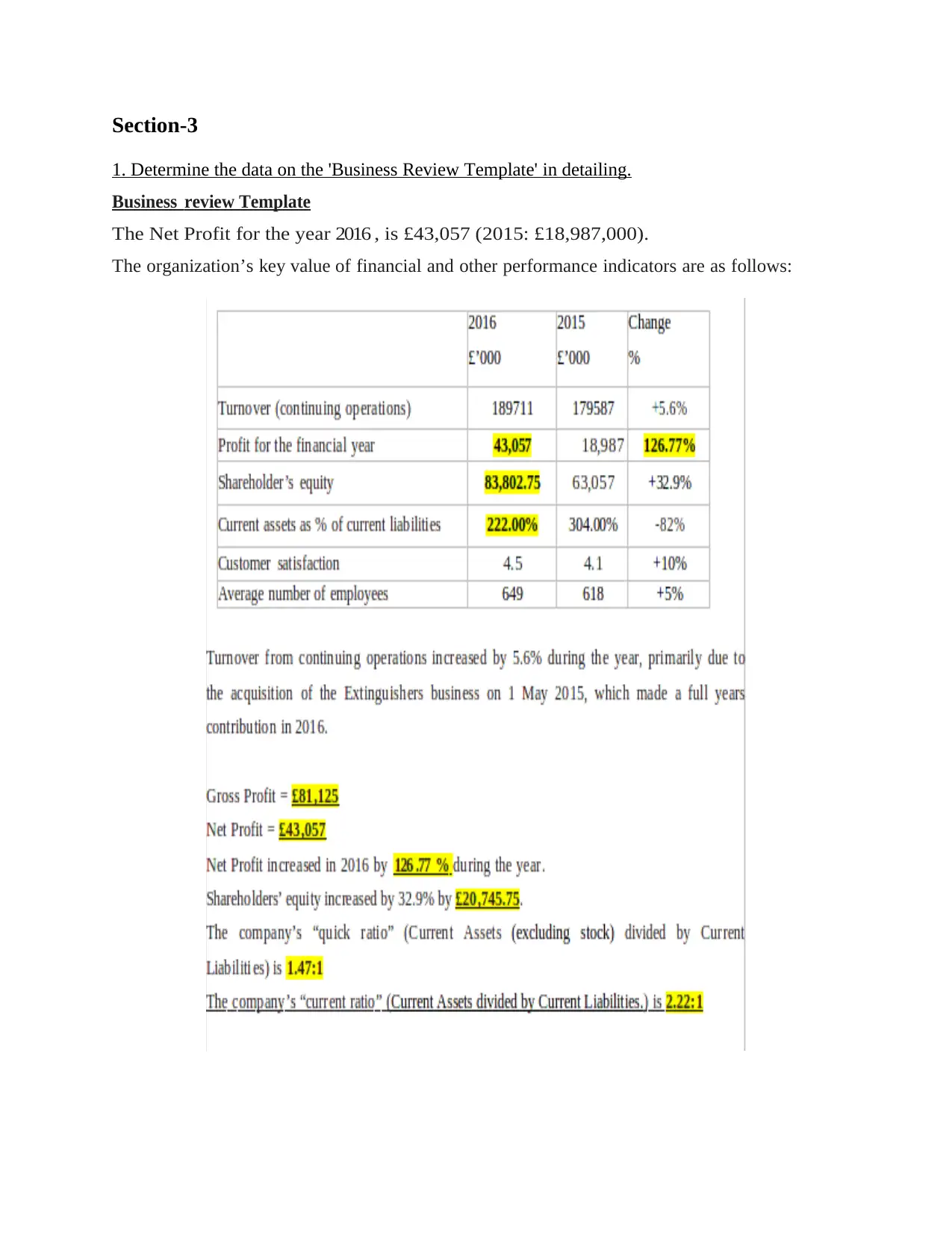
Section-3
1. Determine the data on the 'Business Review Template' in detailing.
Business review Template
The Net Profit for the year 2016 , is £43,057 (2015: £18,987,000).
The organization’s key value of financial and other performance indicators are as follows:
1. Determine the data on the 'Business Review Template' in detailing.
Business review Template
The Net Profit for the year 2016 , is £43,057 (2015: £18,987,000).
The organization’s key value of financial and other performance indicators are as follows:
Paraphrase This Document
Need a fresh take? Get an instant paraphrase of this document with our AI Paraphraser
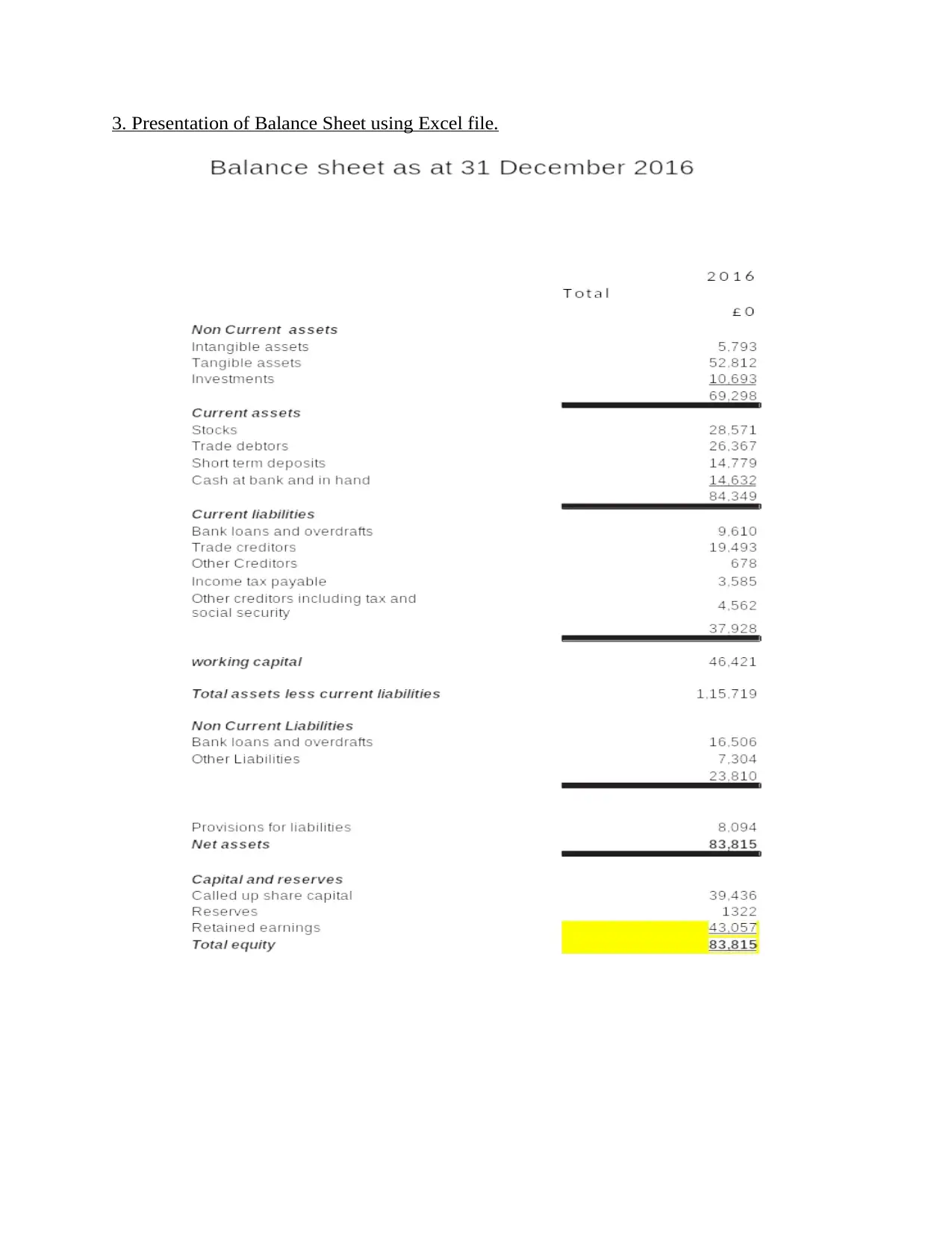
3. Presentation of Balance Sheet using Excel file.
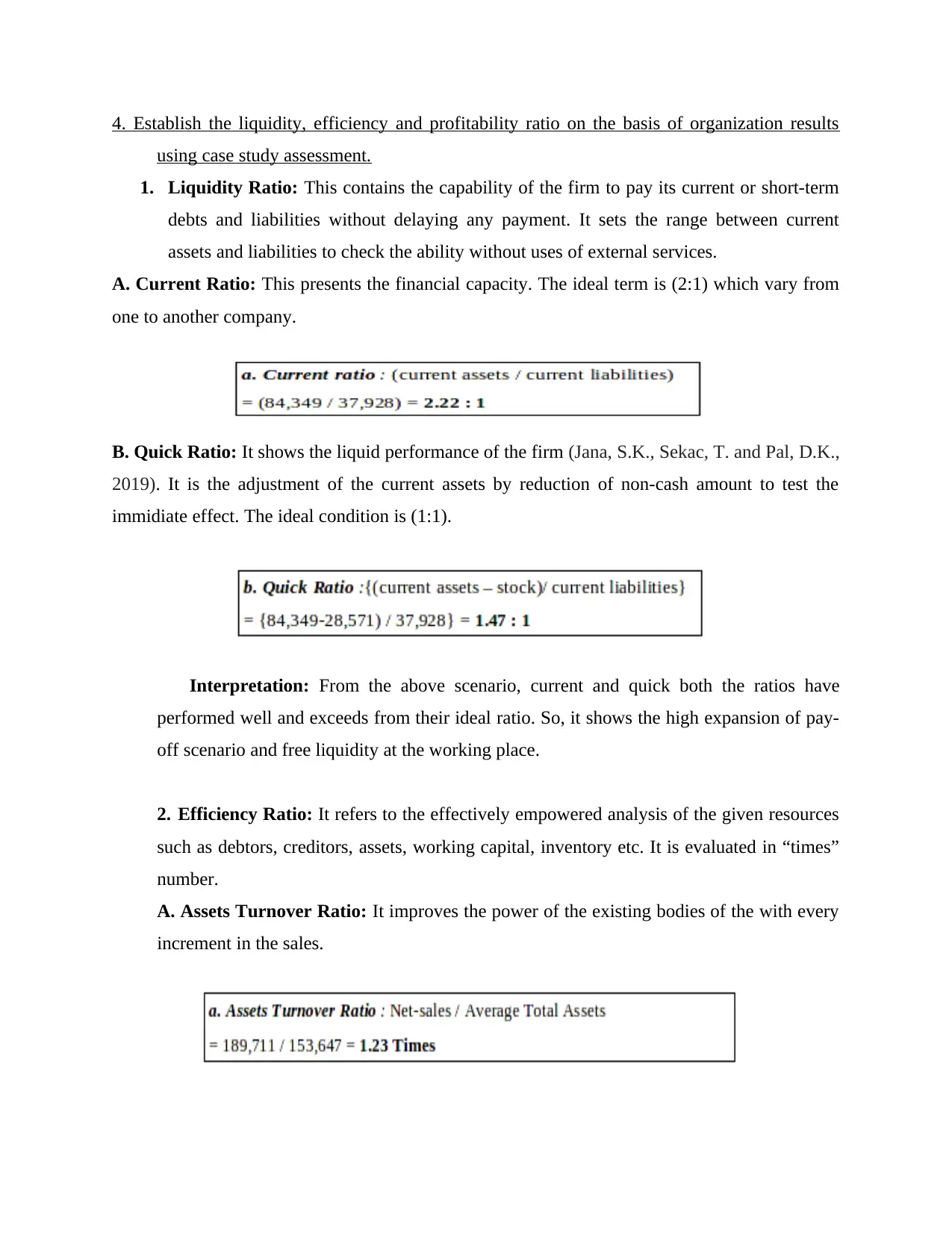
4. Establish the liquidity, efficiency and profitability ratio on the basis of organization results
using case study assessment.
1. Liquidity Ratio: This contains the capability of the firm to pay its current or short-term
debts and liabilities without delaying any payment. It sets the range between current
assets and liabilities to check the ability without uses of external services.
A. Current Ratio: This presents the financial capacity. The ideal term is (2:1) which vary from
one to another company.
B. Quick Ratio: It shows the liquid performance of the firm (Jana, S.K., Sekac, T. and Pal, D.K.,
2019). It is the adjustment of the current assets by reduction of non-cash amount to test the
immidiate effect. The ideal condition is (1:1).
Interpretation: From the above scenario, current and quick both the ratios have
performed well and exceeds from their ideal ratio. So, it shows the high expansion of pay-
off scenario and free liquidity at the working place.
2. Efficiency Ratio: It refers to the effectively empowered analysis of the given resources
such as debtors, creditors, assets, working capital, inventory etc. It is evaluated in “times”
number.
A. Assets Turnover Ratio: It improves the power of the existing bodies of the with every
increment in the sales.
using case study assessment.
1. Liquidity Ratio: This contains the capability of the firm to pay its current or short-term
debts and liabilities without delaying any payment. It sets the range between current
assets and liabilities to check the ability without uses of external services.
A. Current Ratio: This presents the financial capacity. The ideal term is (2:1) which vary from
one to another company.
B. Quick Ratio: It shows the liquid performance of the firm (Jana, S.K., Sekac, T. and Pal, D.K.,
2019). It is the adjustment of the current assets by reduction of non-cash amount to test the
immidiate effect. The ideal condition is (1:1).
Interpretation: From the above scenario, current and quick both the ratios have
performed well and exceeds from their ideal ratio. So, it shows the high expansion of pay-
off scenario and free liquidity at the working place.
2. Efficiency Ratio: It refers to the effectively empowered analysis of the given resources
such as debtors, creditors, assets, working capital, inventory etc. It is evaluated in “times”
number.
A. Assets Turnover Ratio: It improves the power of the existing bodies of the with every
increment in the sales.
⊘ This is a preview!⊘
Do you want full access?
Subscribe today to unlock all pages.

Trusted by 1+ million students worldwide
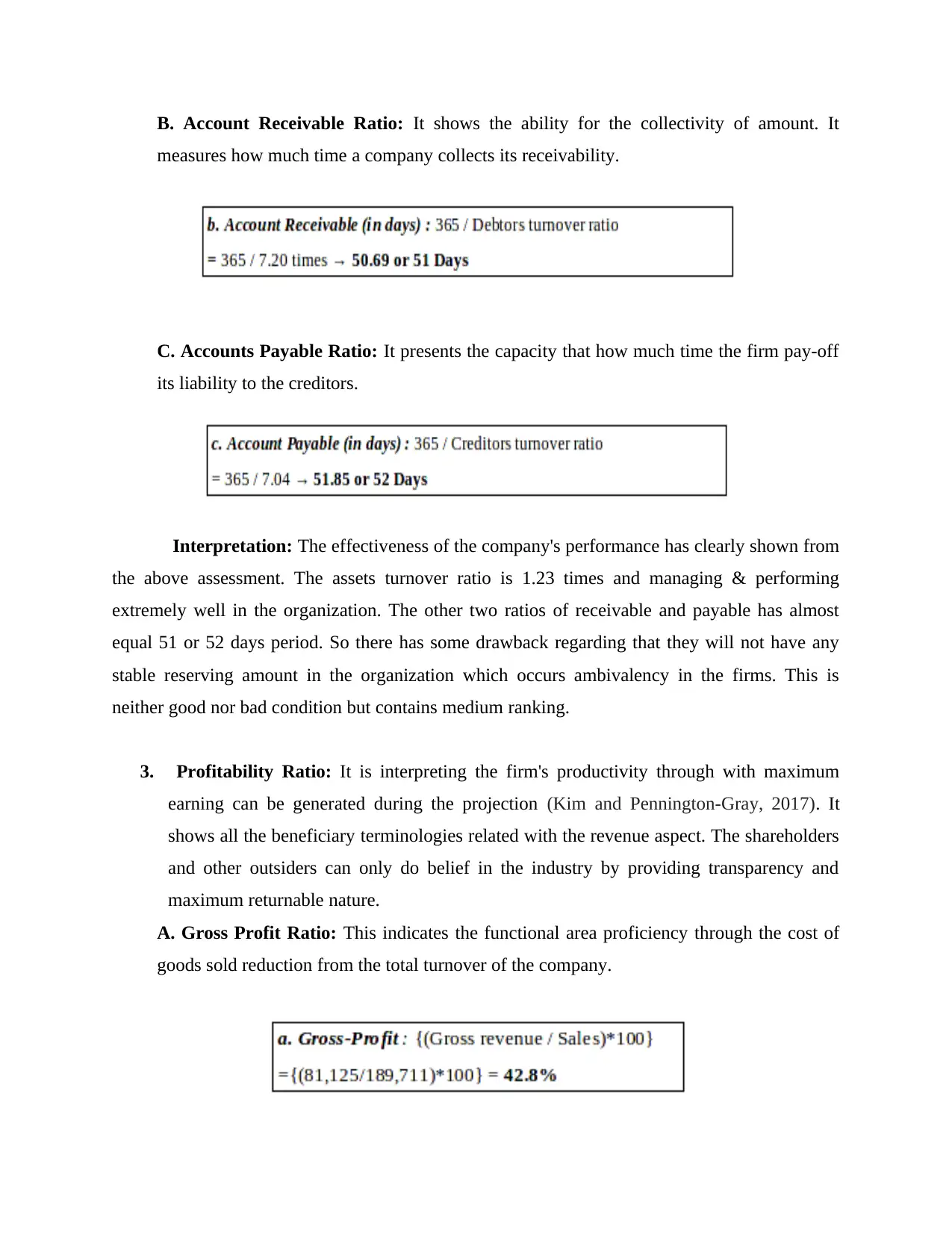
B. Account Receivable Ratio: It shows the ability for the collectivity of amount. It
measures how much time a company collects its receivability.
C. Accounts Payable Ratio: It presents the capacity that how much time the firm pay-off
its liability to the creditors.
Interpretation: The effectiveness of the company's performance has clearly shown from
the above assessment. The assets turnover ratio is 1.23 times and managing & performing
extremely well in the organization. The other two ratios of receivable and payable has almost
equal 51 or 52 days period. So there has some drawback regarding that they will not have any
stable reserving amount in the organization which occurs ambivalency in the firms. This is
neither good nor bad condition but contains medium ranking.
3. Profitability Ratio: It is interpreting the firm's productivity through with maximum
earning can be generated during the projection (Kim and Pennington-Gray, 2017). It
shows all the beneficiary terminologies related with the revenue aspect. The shareholders
and other outsiders can only do belief in the industry by providing transparency and
maximum returnable nature.
A. Gross Profit Ratio: This indicates the functional area proficiency through the cost of
goods sold reduction from the total turnover of the company.
measures how much time a company collects its receivability.
C. Accounts Payable Ratio: It presents the capacity that how much time the firm pay-off
its liability to the creditors.
Interpretation: The effectiveness of the company's performance has clearly shown from
the above assessment. The assets turnover ratio is 1.23 times and managing & performing
extremely well in the organization. The other two ratios of receivable and payable has almost
equal 51 or 52 days period. So there has some drawback regarding that they will not have any
stable reserving amount in the organization which occurs ambivalency in the firms. This is
neither good nor bad condition but contains medium ranking.
3. Profitability Ratio: It is interpreting the firm's productivity through with maximum
earning can be generated during the projection (Kim and Pennington-Gray, 2017). It
shows all the beneficiary terminologies related with the revenue aspect. The shareholders
and other outsiders can only do belief in the industry by providing transparency and
maximum returnable nature.
A. Gross Profit Ratio: This indicates the functional area proficiency through the cost of
goods sold reduction from the total turnover of the company.
Paraphrase This Document
Need a fresh take? Get an instant paraphrase of this document with our AI Paraphraser

B. Net Profit Ratio: It represents the overall margin of the industry which calculated
through the reduction of all the administration, selling and other expenses from the gross-
income.
Interpretation: From the upper case study solution, It clearly shows that overall benefit
are less than the operational income because of high administrative, selling and other
expenses occurs. If the firm will do less expenses in future, they can generating more gains
than now.
Section-4
Implement the procedure of improving their financial performance with using examples.
Financial outcomes are always initiative from the firm's perspective because they have
been using all the available resources and new opportunities to grow up in the external market
place. They aimed one thing of proper utilization of sources and generates maximum revenues
from them. By doing this, they can be in the stable condition by overll scenario (Lee and Park,
2019). Either they maintained the internal workforce well-being and standards or gain outsiders
trust, loyalty and shows transparency in the real-life schemes.
There are many ways of improving organization performances:
1. Human Resources engagement: When the human resources satisfied from the
organization, they are performing extremely good not because accomplishment of
individual interest but also firm's goals & objective. They enhances their capability,
efficiency and productivity in whole manner. By these segments, reduction of costs &
wastage automatically and increase the proficiency with value.
2. Reduction in non-operating expenses: When the expenditure occurs in the company is
relatively low, net margin shows high increament. So, company should do only important
expenses for the productivity purpose, not for unusual pay-outs or losses.
3. Influencial policy for outsiders: When the organization occurring high returns, the
external partners like shareholders and agents are more actively participate in the
through the reduction of all the administration, selling and other expenses from the gross-
income.
Interpretation: From the upper case study solution, It clearly shows that overall benefit
are less than the operational income because of high administrative, selling and other
expenses occurs. If the firm will do less expenses in future, they can generating more gains
than now.
Section-4
Implement the procedure of improving their financial performance with using examples.
Financial outcomes are always initiative from the firm's perspective because they have
been using all the available resources and new opportunities to grow up in the external market
place. They aimed one thing of proper utilization of sources and generates maximum revenues
from them. By doing this, they can be in the stable condition by overll scenario (Lee and Park,
2019). Either they maintained the internal workforce well-being and standards or gain outsiders
trust, loyalty and shows transparency in the real-life schemes.
There are many ways of improving organization performances:
1. Human Resources engagement: When the human resources satisfied from the
organization, they are performing extremely good not because accomplishment of
individual interest but also firm's goals & objective. They enhances their capability,
efficiency and productivity in whole manner. By these segments, reduction of costs &
wastage automatically and increase the proficiency with value.
2. Reduction in non-operating expenses: When the expenditure occurs in the company is
relatively low, net margin shows high increament. So, company should do only important
expenses for the productivity purpose, not for unusual pay-outs or losses.
3. Influencial policy for outsiders: When the organization occurring high returns, the
external partners like shareholders and agents are more actively participate in the
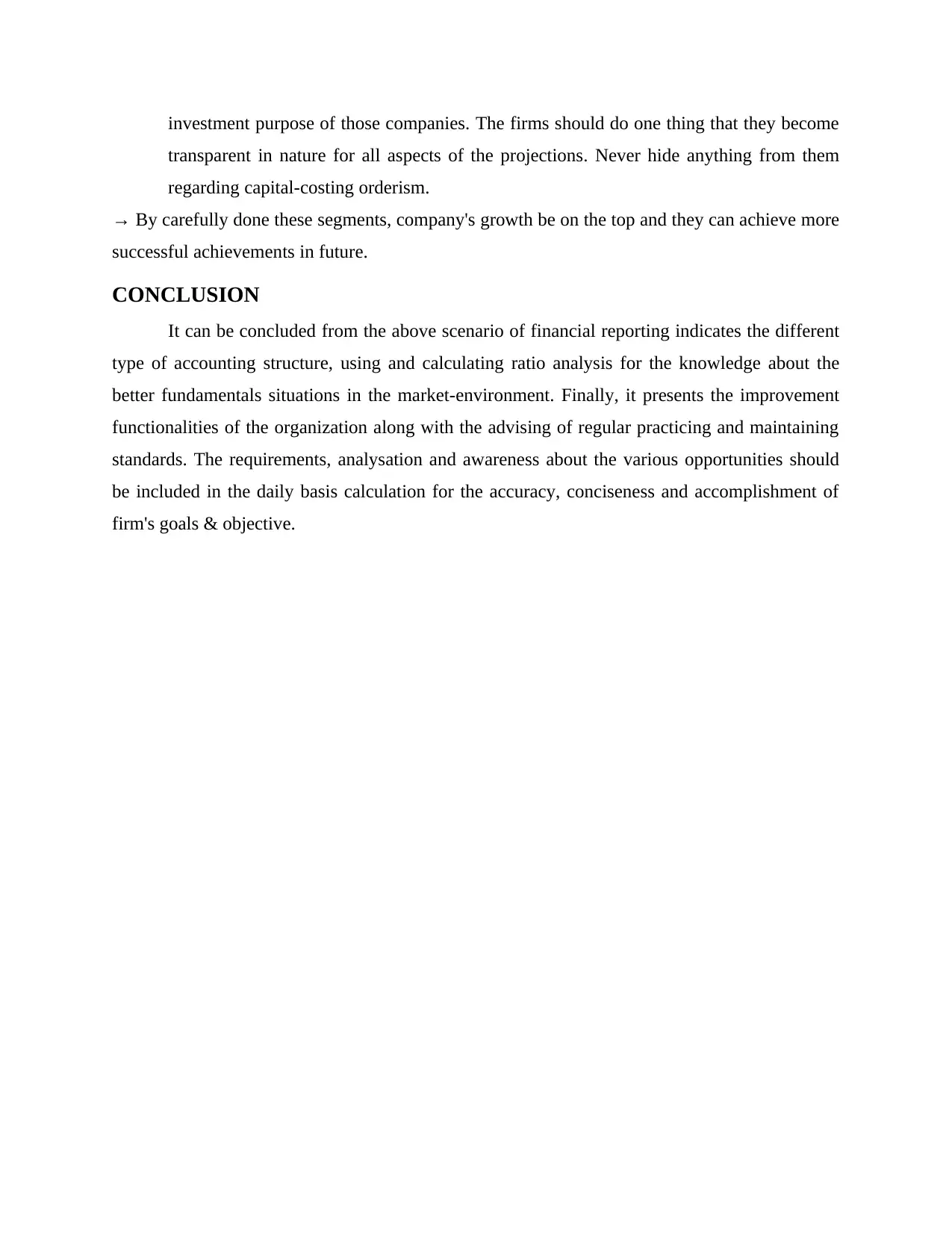
investment purpose of those companies. The firms should do one thing that they become
transparent in nature for all aspects of the projections. Never hide anything from them
regarding capital-costing orderism.
→ By carefully done these segments, company's growth be on the top and they can achieve more
successful achievements in future.
CONCLUSION
It can be concluded from the above scenario of financial reporting indicates the different
type of accounting structure, using and calculating ratio analysis for the knowledge about the
better fundamentals situations in the market-environment. Finally, it presents the improvement
functionalities of the organization along with the advising of regular practicing and maintaining
standards. The requirements, analysation and awareness about the various opportunities should
be included in the daily basis calculation for the accuracy, conciseness and accomplishment of
firm's goals & objective.
transparent in nature for all aspects of the projections. Never hide anything from them
regarding capital-costing orderism.
→ By carefully done these segments, company's growth be on the top and they can achieve more
successful achievements in future.
CONCLUSION
It can be concluded from the above scenario of financial reporting indicates the different
type of accounting structure, using and calculating ratio analysis for the knowledge about the
better fundamentals situations in the market-environment. Finally, it presents the improvement
functionalities of the organization along with the advising of regular practicing and maintaining
standards. The requirements, analysation and awareness about the various opportunities should
be included in the daily basis calculation for the accuracy, conciseness and accomplishment of
firm's goals & objective.
⊘ This is a preview!⊘
Do you want full access?
Subscribe today to unlock all pages.

Trusted by 1+ million students worldwide
1 out of 15
Related Documents
Your All-in-One AI-Powered Toolkit for Academic Success.
+13062052269
info@desklib.com
Available 24*7 on WhatsApp / Email
![[object Object]](/_next/static/media/star-bottom.7253800d.svg)
Unlock your academic potential
Copyright © 2020–2025 A2Z Services. All Rights Reserved. Developed and managed by ZUCOL.



